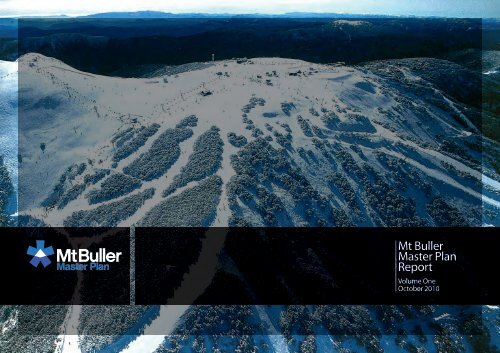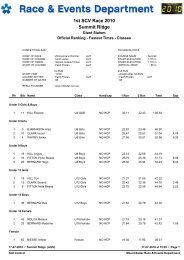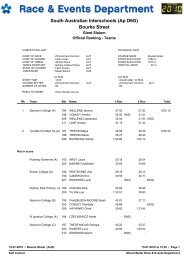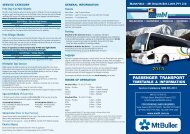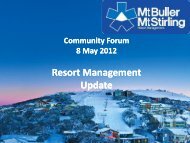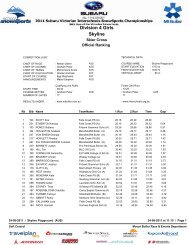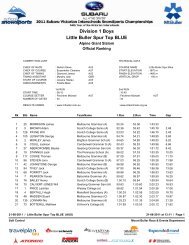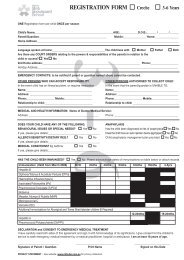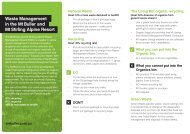Mt Buller Master Plan Report
Mt Buller Master Plan Report
Mt Buller Master Plan Report
You also want an ePaper? Increase the reach of your titles
YUMPU automatically turns print PDFs into web optimized ePapers that Google loves.
<strong>Mt</strong> <strong>Buller</strong><br />
<strong>Master</strong> <strong>Plan</strong><br />
<strong>Report</strong><br />
Volume One<br />
October 2010
Revision 4.1
<strong>Mt</strong> <strong>Buller</strong> Alpine Resort is set in a distinctive environment where magnificent forests, expansive vistas,<br />
seasonal climate, long cultural heritage and rare flora and fauna combine to offer an exceptional<br />
and precious experience. In the context of the continent of Australia dominated by dry lowlands and<br />
coastal environments, these Alpine and sub-alpine environments represent a very small area.<br />
It is recognised that <strong>Mt</strong> <strong>Buller</strong> must meet the challenges of climate change, continue the<br />
management of its unique environment and maintain its commitment to social issues. With clear<br />
changes in market expectation, limited land availability and the need for environmentally, socially<br />
and economically sustainable development, the <strong>Mt</strong> <strong>Buller</strong> <strong>Master</strong> <strong>Plan</strong> is seen as a blueprint for<br />
coordinated improvements to services and facilities and future development on the Mountain.<br />
In response to this pristine and biodiverse environment, the <strong>Master</strong> <strong>Plan</strong> for the mountain must<br />
acknowledge and honour this very special environment in which it is a privilege to ski, walk, cycle,<br />
stay and own a business. The plan has, at its core, this philosophical basis which flows through to<br />
design, construction and operation of every element.<br />
The <strong>Master</strong> <strong>Plan</strong> represents an opportunity to reimage <strong>Mt</strong> <strong>Buller</strong> and plan for the next 20 years of<br />
growth and change.
<strong>Mt</strong> <strong>Buller</strong><br />
<strong>Master</strong> <strong>Plan</strong><br />
<strong>Report</strong><br />
Project Team<br />
Steering Committee<br />
<strong>Mt</strong> <strong>Buller</strong> & <strong>Mt</strong> Stirling Alpine Resort Management Board<br />
<strong>Buller</strong> Ski Lifts Pty Ltd<br />
Tourism Victoria<br />
Regional Development Victoria<br />
<strong>Mt</strong> <strong>Buller</strong> Chamber of Commerce<br />
Design Team<br />
Cox Architecture<br />
<strong>Master</strong> <strong>Plan</strong>ners<br />
Brent Harley and Associates (Vancouver)<br />
Ski Resort Advice<br />
Arup<br />
Traffic and Civil Engineers<br />
Oculus Landscape and Urban Design<br />
Landscape Architects<br />
Davis Langdon<br />
Statutory <strong>Plan</strong>ning Review<br />
SGS Economics and <strong>Plan</strong>ning<br />
Preliminary Economic Assessment<br />
MOUNT BULLER MASTER PLAN<br />
Town <strong>Plan</strong>ning Review | 20 OCTOBER 2010
New South Wales<br />
ACT<br />
Albury<br />
Kosciusko<br />
National Park<br />
Thredbo Village<br />
Kosciuszko<br />
Jindabyne<br />
<strong>Mt</strong> Beauty<br />
Falls Creek<br />
Mount Hotham<br />
Volume 1<br />
Contents<br />
1 Introduction<br />
1.1 <strong>Mt</strong> <strong>Buller</strong> – More Than A Mountain Melbourne<br />
1.2 The Need For a <strong>Master</strong> <strong>Plan</strong><br />
1.3 The <strong>Master</strong> <strong>Plan</strong><br />
Lake Eildon<br />
Mount <strong>Buller</strong><br />
2 Site<br />
2.1 Site and Context<br />
2.2 Land and Property Ownership<br />
2.3 Cultural Heritage<br />
2.4 Environmental Management<br />
2.5 Transport and Access<br />
2.6 Community and Social Context<br />
2.7 <strong>Plan</strong>ning Framework<br />
Victoria<br />
Alpine<br />
National Park<br />
Bairnsdale<br />
Buchan<br />
Snowy River<br />
National Park<br />
3 The Community’s <strong>Plan</strong><br />
3.1 <strong>Mt</strong> <strong>Buller</strong> Brand Audit - 2007<br />
3.2 Stakeholder Consultation - 2009<br />
3.3 <strong>Mt</strong> <strong>Buller</strong> Beyond 2020<br />
3.4 The <strong>Mt</strong> <strong>Buller</strong> <strong>Master</strong> <strong>Plan</strong> - 2010<br />
Access <strong>Plan</strong><br />
To <strong>Mt</strong> Stirling
4 The <strong>Plan</strong><br />
4.1 The Successful Resort<br />
4.2 The <strong>Master</strong> <strong>Plan</strong><br />
4.3 Horse Hill Gateway<br />
4.4 Valley North Development<br />
4.5 The Village Centre<br />
4.6 Athlete’s and Black Forest Walks<br />
4.7 The Wider Village<br />
4.8 Connections<br />
4.9 Development Opportunities<br />
4.10 The Skifields<br />
5 Movement<br />
5.1 Access Principles<br />
5.2 Parking<br />
5.3 Interchange<br />
6 The Environment<br />
6.1 Sustainability Strategy<br />
6.2 Built Form<br />
6.3 Landscape Response<br />
7 The Way Ahead<br />
7.1 Implementation<br />
7.2 Project Priorities<br />
7.3 Project Feasibility<br />
7.4 Statutory Framework
1.0<br />
Introduction<br />
1.1<br />
<strong>Mt</strong> <strong>Buller</strong> – More Than<br />
A Mountain<br />
<strong>Mt</strong> <strong>Buller</strong> was initially founded by people’s desire<br />
to ski and access the snow. It has grown from<br />
the community’s desire to enjoy, live and work in<br />
the site’s remarkable alpine environment. From a<br />
handful of lodges built by members in the 1950’s,<br />
it has grown to be a major resort and summer<br />
and winter attraction.<br />
The <strong>Mt</strong> <strong>Buller</strong> <strong>Master</strong> <strong>Plan</strong> aims to be a catalyst<br />
not only for the ongoing winter growth of the<br />
resort but in the development of a sustainable<br />
year-round economy.<br />
It is recognised that <strong>Mt</strong> <strong>Buller</strong> must meet the<br />
challenges of climate change, continue the<br />
management of its unique environment and<br />
maintain its commitment to social issues. With<br />
clear changes in market expectation, limited<br />
land availability and the need for environmentally,<br />
socially and economically sustainable<br />
development, the <strong>Master</strong> <strong>Plan</strong> is seen as a<br />
blueprint for coordinated improvements to<br />
services and facilities and future development on<br />
the Mountain.<br />
In response to this pristine and biodiverse<br />
environment, the master plan for the mountain<br />
must acknowledge and honour this very special<br />
environment in which it is a privilege to ski, walk,<br />
cycle, stay and own a business. The plan has,<br />
at its core, this philosophical basis which flows<br />
through to design, construction and operation of<br />
every element.<br />
The Resort <strong>Master</strong> <strong>Plan</strong> is a jointly funded by<br />
the <strong>Mt</strong> <strong>Buller</strong> and <strong>Mt</strong> Stirling Alpine Resort<br />
Management Board (ARMB), <strong>Buller</strong> Ski Lifts<br />
(BSL), Regional Development Victoria and<br />
Tourism Victoria . The funding support of Tourism<br />
Victoria and Regional Development Victoria is in<br />
recognition of the significant contribution of <strong>Mt</strong><br />
<strong>Buller</strong> to Victoria’s economy.<br />
8 <strong>Mt</strong> <strong>Buller</strong> <strong>Master</strong> <strong>Plan</strong> <strong>Report</strong>
Road Map Diagram<br />
1.2<br />
The Need For A <strong>Master</strong> <strong>Plan</strong><br />
The Victorian State Government manages and<br />
supports the <strong>Mt</strong> <strong>Buller</strong> and <strong>Mt</strong> Stirling resort<br />
areas, through the Alpine Resort Management<br />
Board. Both the Government and the private<br />
sector have made and continue to make<br />
considerable investments in maintaining this<br />
extraordinary place and its surrounds and<br />
creating opportunities to live, work and play at <strong>Mt</strong><br />
<strong>Buller</strong> and its sister mountain, <strong>Mt</strong> Stirling.<br />
The aim of the <strong>Mt</strong> <strong>Buller</strong> <strong>Master</strong> <strong>Plan</strong> is to provide<br />
a blueprint for cohesive, economically feasible<br />
and environmentally sustainable development<br />
that will position the <strong>Mt</strong> <strong>Buller</strong> Resort beyond<br />
2020. It will provide a blueprint and incentive for<br />
government, business and private investors to<br />
continue to invest in <strong>Mt</strong> <strong>Buller</strong> in the future.<br />
In preparing for the <strong>Master</strong> <strong>Plan</strong>, five broad<br />
objectives were identified:<br />
* Improve visitor amenity and commercial<br />
offer of the <strong>Mt</strong> <strong>Buller</strong> Village<br />
* Improve visitor access to, from, and within the<br />
<strong>Mt</strong> <strong>Buller</strong> Village<br />
* Improve the interface between the<br />
<strong>Mt</strong> <strong>Buller</strong> Village and activity areas<br />
(existing and proposed)<br />
* Improve access to <strong>Mt</strong> <strong>Buller</strong> and<br />
tourism links between <strong>Mt</strong> <strong>Buller</strong> and<br />
<strong>Mt</strong> Stirling area<br />
* Develop the required activity infrastructure<br />
to support year round visitation and further<br />
development and investment.<br />
1.3<br />
The <strong>Master</strong> <strong>Plan</strong><br />
The <strong>Master</strong> <strong>Plan</strong> identifies a new consolidated<br />
and coordinated direction for future development<br />
of <strong>Mt</strong> <strong>Buller</strong>. It specifically does not prescribe<br />
fixed solutions but instead creates a road map for<br />
development over the next decade and beyond.<br />
Key projects and priorities for the mountain<br />
are identified and the scope and direction<br />
of future works and studies are outlined and<br />
prioritised. Each of these elements will need to<br />
be developed further in the future as funding and<br />
opportunities arise.<br />
The <strong>Master</strong> <strong>Plan</strong> ensures that future development<br />
at <strong>Mt</strong> <strong>Buller</strong> proceeds within a clear and<br />
supported framework. It provides certainty for<br />
stakeholders and confidence for Government<br />
that <strong>Mt</strong> <strong>Buller</strong>’s future is coordinated and<br />
sustainable.<br />
The list of projects is for futher investigation only<br />
and does not constitute approval. All projects<br />
will be required to undertake all necessary<br />
studies and comply with all relevant State<br />
and Commonwealth legislative and policy<br />
requirements.<br />
Policy<br />
Inputs<br />
• Alpine Resorts 2020 Strategy<br />
• Alpine Resorts <strong>Plan</strong>ning Scheme<br />
• Victorian Trails Strategy<br />
• Alpine Resorts Leasing Policy<br />
• Victoria’s Nature Based Tourism Strategy<br />
• Victoria’s Native Vegetation Management – A Framework for Action<br />
• <strong>Mt</strong> Stirling Environmental Effects Statement<br />
• 2007-2012 Transport Strategy, October 2004, <strong>Mt</strong> <strong>Buller</strong> and <strong>Mt</strong> Stirling ARMB<br />
• <strong>Mt</strong> <strong>Buller</strong> and <strong>Mt</strong> Stirling Alpine Resorts Environmental Management <strong>Plan</strong><br />
• Mansfield <strong>Mt</strong> <strong>Buller</strong> the High Country – Arts, Culture and Heritage <strong>Plan</strong><br />
Public Display<br />
Consultation<br />
Stakeholder<br />
Engagement:<br />
Public<br />
Government<br />
Commercial<br />
Draft<br />
<strong>Master</strong> <strong>Plan</strong><br />
2009<br />
Stakeholder<br />
Consultation<br />
Charette<br />
Stakeholder<br />
Engagement:<br />
Government<br />
Commercial<br />
Root Projects<br />
<strong>Master</strong> <strong>Plan</strong><br />
Brief<br />
Visioning<br />
Workshop<br />
Stakeholder<br />
Engagement:<br />
Government<br />
Commercial<br />
Data Collection<br />
& Analysis<br />
The <strong>Mt</strong> <strong>Buller</strong> <strong>Master</strong> <strong>Plan</strong> identifies<br />
development options within a social, economic<br />
and environmental/ecological framework to<br />
ensure sustainable development that protects<br />
the unique cultural, environmental and heritage<br />
values of <strong>Mt</strong> <strong>Buller</strong>.<br />
The <strong>Master</strong> <strong>Plan</strong> is in line with the Victorian<br />
Government’s Alpine Resorts 2020 Strategy<br />
(2004), which underpins the ARMB’s<br />
commitment to optimise winter use and build<br />
summer visitation to establish a sustainable yearround<br />
economy at <strong>Mt</strong> <strong>Buller</strong>.<br />
<strong>Mt</strong> <strong>Buller</strong><br />
<strong>Master</strong> <strong>Plan</strong><br />
<strong>Report</strong><br />
<strong>Master</strong> <strong>Plan</strong><br />
Priorities<br />
Mirimbah Gate<br />
• New Entry Building<br />
• RFID Drive Through Ticketing<br />
• Improved Visitor Orientation<br />
• Park Activation<br />
• Base Station for Camping, Mountain Bike<br />
and Hiking Trails<br />
Horse Hill<br />
• Entry Statement<br />
• Facilities Building<br />
• Snow Play Zone<br />
• Gondola Link to Village Centre<br />
• Bus Drop -Off to Facilities Building<br />
• Reconfigured Precinct Parking<br />
• New Parking at Workshop Sites<br />
• Bus Parking at Corn Hill Road<br />
• Improved Wayfinding<br />
• Summer Activity Platform<br />
Village<br />
• Develop Village Square with:<br />
• Axial link to church and mountain<br />
• Multi-level linked colonnade and balcony<br />
• Weather protection from north<br />
• Restaurant and retail focus<br />
• Improved ski linkages<br />
• New Public Shelter and Facilities<br />
• Gondola link to Horse Hill<br />
• Village Car Parking (400 cars)<br />
• Bus Terminal at Transport Hub<br />
• Athletes Walk redeveloped<br />
• Black Forest Walk redeveloped<br />
• Improved Village / Mountain interface<br />
• Improved Wayfinding<br />
• Create Summer Sports Hub<br />
• Improved Links to Eastern Village<br />
Implementation<br />
Further Studies<br />
Required<br />
Figure 1.1 - <strong>Plan</strong>ning Road Map<br />
9 <strong>Mt</strong> <strong>Buller</strong> <strong>Master</strong> <strong>Plan</strong> <strong>Report</strong>
2.0<br />
Site<br />
2.1<br />
Site and Context<br />
2.2<br />
Land and Property Ownership<br />
<strong>Mt</strong> <strong>Buller</strong> Alpine Resort is located some 250<br />
kilometres north east of Melbourne and is one<br />
of the largest of Victoria’s six alpine resorts. The<br />
resort, located on the Great Dividing Range with<br />
a summit elevation of 1,804 meters, includes<br />
approximately 2,300 hectares of Crown Land,<br />
which is managed by the ARMB pursuant to the<br />
Alpine Resorts (Management) Act 1997. The<br />
significance of the region’s environmental and<br />
cultural values has recently been recognised by<br />
its inclusion on the National Heritage Register.<br />
<strong>Mt</strong> <strong>Buller</strong> Village and ski infrastructure occupy<br />
850 hectares of the Resort, including 180<br />
hectares of ski trails and open space above the<br />
tree line and 300 hectares of skiable terrain.<br />
The centre of the Village was a highland grazing<br />
campsite prior to the mid 1960’s and aboriginal<br />
artefacts have been documented in this area.<br />
The distinctive character of the Village has<br />
developed over the years in response to its<br />
topography and uses. It has an hourglass<br />
plan-form, narrowing at the centre of the ‘saddle’<br />
between Baldy and One Tree Hill. The Village<br />
accommodates over 7,000 visitors per night<br />
during the snow season.<br />
The ski fields lie to the west of the Village Centre<br />
with the main ski run, Bourke Street, running into<br />
the Village. The ski fields naturally developed in<br />
areas with the best snow and offer a range of<br />
runs suited to all levels of skiers and boarders.<br />
Melbourne<br />
To the east and adjacent to the Bourke<br />
Street spur, residential lodges and hotels are<br />
set below the tree line within sub-alpine<br />
woodland vegetation.<br />
It is home to approximately 50-100 permanent<br />
residents year round.<br />
Access <strong>Plan</strong><br />
Lake Eildon<br />
Mount Hotham<br />
Mount <strong>Buller</strong><br />
Victoria<br />
New South Wales<br />
Albury<br />
<strong>Mt</strong> Beauty<br />
Falls Creek<br />
Alpine<br />
National Park<br />
Bairnsdale<br />
Thredbo Village<br />
Kosciuszko<br />
Buchan<br />
Kosciusko<br />
National Park<br />
Snowy River<br />
National Park<br />
MT BULLER STRATEGIC STATEMENT - CLAUSE 21.05-3 PAGE 4 OF 7<br />
ACT<br />
Jindabyne<br />
Figure 2.1 - <strong>Mt</strong> <strong>Buller</strong> Location <strong>Plan</strong><br />
<strong>Mt</strong> <strong>Buller</strong> Alpine Resort comprises Crown Land<br />
permanently reserved under the Crown Land<br />
(Reserves) Act 1978. In accordance with the<br />
Alpine Resorts (Management) Act 1997, the<br />
ARMB has the power to grant leases on any land<br />
within the Resort.<br />
Leasing policy is crucial to the management,<br />
operations and financing of the Resort by the<br />
ARMB. Leases are granted for varying periods of<br />
up to 51 years for substantial investments.<br />
Figure 2.2 - <strong>Mt</strong> <strong>Buller</strong> Resort Precincts<br />
To <strong>Mt</strong> Stirling<br />
10 <strong>Mt</strong> <strong>Buller</strong> <strong>Master</strong> <strong>Plan</strong> <strong>Report</strong>
2.3<br />
Cultural Heritage<br />
The Taungurung<br />
Before the arrival of Europeans, the land around<br />
<strong>Mt</strong> <strong>Buller</strong> was the country of the Taungurung<br />
aboriginal tribe, one of the five groups from the<br />
Kulin Nation language group. The tribe was<br />
comprised of nine clan groups and it was the<br />
Yowung-illam-balluk clan who inhabited the<br />
area along the Goulburn River as far as<br />
Alexandra, through to the Howqua, Delatite<br />
and Jamieson Rivers and the mountains like <strong>Mt</strong><br />
Stirling and <strong>Mt</strong> <strong>Buller</strong> that shed their waters into<br />
those rivers.<br />
The high mountain region was not only a source<br />
of food such as the Bogong moths that migrated<br />
to the area in summer, but also a location for<br />
ceremonies and meeting of the Taungurung<br />
clans.<br />
Descendants of the Taungurung people<br />
are looking to strengthen their ties with their<br />
traditional country and the ARMB is looking<br />
to create employment opportunities on the<br />
mountain through arts and cultural programs.<br />
European arrival, logging and grazing<br />
European explorers Hume and Hovell first<br />
sighted the mountain (known as Marnong by the<br />
Aborigines) in 1824. The surveyor Major Thomas<br />
Mitchell bestowed the name of the British colonial<br />
official Charles <strong>Buller</strong> on the mountain in 1836<br />
while the German botanist Ferdinand von Mueller<br />
was the first European to ascend the mountain in<br />
1853.<br />
The post-contact settlement of <strong>Mt</strong> <strong>Buller</strong><br />
commenced following early explorations by<br />
squatters and cattle graziers. These high country<br />
cattlemen constructed a number of alpine huts<br />
for shelter and refuge during mustering.<br />
Development of the winter resort<br />
In the 1890s European miners are thought<br />
to have crafted skis from fence palings and<br />
schussed down the mountains, cutting a trail for<br />
recreational skiing. In 1913, the Klingsporn family,<br />
who had improved the track leading to <strong>Mt</strong> <strong>Buller</strong><br />
to make it more accessible for cattle grazing,<br />
was granted funds for improved access by the<br />
Victorian Government.<br />
The ski industry proper began in 1924 after the Ski<br />
Club of Victoria presented a promotional brochure<br />
including a photograph of a snow capped <strong>Mt</strong> <strong>Buller</strong><br />
at its inaugaural meeting. In 1929 the first chalet<br />
was built at Horse Hill.<br />
Helmut Kofler, a pioneer of Victorian skiing, made<br />
<strong>Mt</strong> <strong>Buller</strong> his home in 1938 and, with wife Peggy<br />
Wylkes, was responsible for the Resort's early<br />
development. In 1946 a road was built to reach the<br />
fledgling <strong>Mt</strong> <strong>Buller</strong> Village. By 1948, the <strong>Mt</strong> <strong>Buller</strong><br />
Alpine Reserve Committee of Management was<br />
in control of tourism, quickly developing the area<br />
with a number of ski lodges and downhill ski runs,<br />
including the first tow on <strong>Mt</strong> <strong>Buller</strong> in 1949. The first<br />
Doppelmayr double chairlift opened on Bourke<br />
Street in 1964.<br />
The development of <strong>Mt</strong> <strong>Buller</strong> as a tourist resort<br />
was accompanied by the eventual phasing out of<br />
summer grazing in the 1970s.<br />
In 1997, the first World Cup Aerials were held on<br />
<strong>Mt</strong> <strong>Buller</strong> and in the same year the Alpine Resorts<br />
Commission was replaced by individual Resort<br />
Management Boards, and the Alpine Resorts<br />
Coordinating Council.<br />
In 2004, then Minister for the Environment,<br />
John Thwaites, announced the abolition of the<br />
<strong>Mt</strong> Stirling Resort Management Board and the<br />
creation of the <strong>Mt</strong> <strong>Buller</strong> and <strong>Mt</strong> Stirling Alpine<br />
Resort Management Board.<br />
2.4<br />
Environmental Management<br />
<strong>Mt</strong> <strong>Buller</strong> Alpine Resort is part of the unique<br />
alpine environment containing rare flora, fauna<br />
and geology.<br />
The <strong>Mt</strong> <strong>Buller</strong>/<strong>Mt</strong> Stirling region is the location<br />
of six nationally significant endangered species<br />
of fauna: the Caddisfly; Mountain Pygmy-<br />
Possum; Alpine Bog Skink; the Stonefly; the<br />
Barred Galaxias; and the Alpine Stonefly.<br />
These species are protected pursuant to the<br />
Federal Environment Protection and Biodiversity<br />
Conservation Act (EPBC).<br />
The ARMB’s Environmental Management <strong>Plan</strong><br />
states that 38 rare or threatened vascular plants<br />
and two threatened plant communities have<br />
been recorded within the <strong>Mt</strong> <strong>Buller</strong> and <strong>Mt</strong> Stirling<br />
resorts. The <strong>Plan</strong> notes that the status of rare<br />
or threatened plants within the Resorts is not<br />
well known. Future environmental management<br />
actions are designed to increase the ARMB’s<br />
knowledge and understanding of these plants<br />
and plant communities.<br />
Development within the Resort must take<br />
account of, among other things, the <strong>Mt</strong> <strong>Buller</strong><br />
Environmental Management <strong>Plan</strong> as well as the<br />
directions under Victoria’s “Native Vegetation<br />
Management – A Framework for Action” that<br />
establishes the principle of ‘net gain’ in native<br />
vegetation when considering the possible<br />
expansion of the Resort and the existing<br />
precincts. Development must comply with<br />
relevant legislation including the State Flora &<br />
Fauna Guarantee Act.<br />
The natural environment and landscape is<br />
the key attribute of the <strong>Mt</strong> <strong>Buller</strong> Resort and<br />
is key to its appeal for visitors year round,<br />
although it is the snow cover that remains the<br />
biggest attraction.<br />
11 <strong>Mt</strong> <strong>Buller</strong> <strong>Master</strong> <strong>Plan</strong> <strong>Report</strong>
2.5<br />
Transport and Access<br />
Winter transport and parking<br />
<strong>Mt</strong> <strong>Buller</strong> is approximately three and a half hours<br />
drive from Melbourne and is the most accessible<br />
of the major Victorian alpine resorts. Access to<br />
the Resort is critical to its operation during the<br />
declared snow season.<br />
Entry to the Resort during the snow season is<br />
controlled at the Mirimbah gate where visitors<br />
arriving by car pay a per vehicle entry charge<br />
based on the intended duration of their stay in<br />
the Village. Bus passengers are charged on a<br />
per person basis.<br />
Currently the only access route to <strong>Mt</strong> <strong>Buller</strong> is<br />
via the <strong>Mt</strong> <strong>Buller</strong> Tourist Road – a winding 16km<br />
road rising from Mirimbah to <strong>Mt</strong> <strong>Buller</strong> Village.<br />
All overnight visitors to the Village are required to<br />
carry chains and in extreme weather conditions<br />
visitors to the mountain are required to fit chains<br />
as a condition of Resort entry in response to road<br />
conditions. The two-way single-lane road has<br />
a series of chain fitting bays between Mirimbah<br />
and the Horse Hill carpark however there are no<br />
overtaking lanes.<br />
Visitors can access the mountain during winter in<br />
three ways:<br />
* Bus transport, mostly from Melbourne, to<br />
Mansfield, and on to <strong>Mt</strong> <strong>Buller</strong><br />
* Park off the mountain in Mansfield or at the<br />
Mirimbah gate and be transported by bus to<br />
the Village<br />
* Drive to the short or long-term car parks located<br />
at points along the <strong>Mt</strong> <strong>Buller</strong> Tourist Road<br />
During the winter season, ARMB provides a<br />
free day shuttle service for day visitors between<br />
the car parks and the Village. The carpark to<br />
Village shuttle service does not cater for luggage<br />
so overnight visitors are required to use the<br />
mountain taxi service to transport their luggage<br />
and equipment to their ski lodge, apartment or<br />
hotel at an additional charge. Within the Village, a<br />
free shuttle bus operates from 8am-6pm during<br />
winter. There is no public transport outside of the<br />
snow season. A school bus operates year round<br />
based on resident student demand.<br />
A limited amount of public car parking is available<br />
within the Village and private car parking is also<br />
available in association with accommodation.<br />
The ARMB controls parking within the Village<br />
during the ski season through a paid permit<br />
system, available only to 4WD vehicles. ARMB’s<br />
policy is to encourage off street parking within the<br />
Village and discourages unnecessary driving of<br />
vehicles within the Village.<br />
There is a clear need to improve and streamline<br />
the journey to the resort such that bottlenecks,<br />
danger, indeterminate waiting and discomfort are<br />
eliminated while value for money (paid for entry<br />
and transit) is provided in the form of a smooth,<br />
seamless journey terminating in a welcoming<br />
sense of arrival in the Village.<br />
Non-winter access<br />
Outside of the snow season, there is no entry<br />
fee for access to the Resort and private vehicles<br />
are free to enter the Village and park at kerbside<br />
parking zones. The winter day and overnight<br />
parking areas have limited use during the nonwinter<br />
months.<br />
Streets, tracks, ski trails and walking trails in the<br />
Resort are used as walking and bicycle trails and<br />
there are links to further trails on <strong>Mt</strong> Stirling and<br />
beyond.<br />
There are plans, subject to additional<br />
government funding and planning approval, to<br />
construct a 2WD link road between <strong>Mt</strong> <strong>Buller</strong> and<br />
<strong>Mt</strong> Stirling, to create a touring route that links <strong>Mt</strong><br />
<strong>Buller</strong> Village with the surrounding high country<br />
via a through route and provides alternative<br />
emergency access.<br />
Pedestrians and skiers in the Village<br />
During winter the circulation of Village traffic,<br />
pedestrians and skiers is managed by a range of<br />
measures including the provision of a free intra-<br />
Village shuttle bus service, the limiting of private<br />
vehicles by the issue of permits, and the marking<br />
out of specific paths and routes for pedestrians<br />
and skiers. Bourke Street, the main beginner and<br />
ski school area gets congested and there is an<br />
unsatisfactory mixing of pedestrians, skiers and<br />
snow players.<br />
Ski fields are accessible via the Village or direct<br />
from day carpark by quad chair from the Horse<br />
Hill lift station.<br />
12 <strong>Mt</strong> <strong>Buller</strong> <strong>Master</strong> <strong>Plan</strong> <strong>Report</strong>
2.6<br />
Community and Social<br />
Context<br />
Residents and year-round workers<br />
<strong>Mt</strong> <strong>Buller</strong> is home to a small year-round<br />
community of permanent residents however<br />
the population swells in winter when the snow<br />
season workforce adds a further 2,000 to the<br />
population. Many who make a living on <strong>Mt</strong><br />
<strong>Buller</strong> all year round live in the surrounding<br />
district travelling to the mountain from Sawmill<br />
Settlement, Merrijig and Mansfield.<br />
Visitors – the tourist market<br />
<strong>Mt</strong> <strong>Buller</strong>, in its current form, exists to serve the<br />
tourist market. The Village has the capacity to<br />
accommodate approximately 7,500 people<br />
overnight in a variety of modes from backpacker<br />
beds through club and commercial ski<br />
lodges to hotels, private apartments and staff<br />
accommodation.<br />
The mountain has existing infrastructure in place<br />
to cater for an additional 10,000 visitors on any<br />
given day. It is able to sustain these levels for two<br />
to three consecutive days however core services<br />
such as water supply and sewerage treatment<br />
require several days to stabilise between major<br />
weekend peaks.<br />
Along with ski field infrastructure and<br />
accommodation, the tourist market is also served<br />
by a range of retail and hospitality businesses.<br />
The challenge lies in reducing the seasonal<br />
off-peak troughs through extending the winter<br />
season and increasing summer visitation.<br />
Winter<br />
<strong>Mt</strong> <strong>Buller</strong>’s key strength is its proximity to<br />
Melbourne, enabling snow enthusiasts to<br />
head for the mountain in response to a good<br />
snowfall. The influx of day visitors in such<br />
circumstances (up to 5,000 additional visitors<br />
on a busy weekend in July or August) and the<br />
logistical effort required to handle the influx of the<br />
additional visitors is a key issue to be addressed<br />
in the <strong>Mt</strong> <strong>Buller</strong> <strong>Master</strong> <strong>Plan</strong>.<br />
The ski season sees a dramatic increase in the<br />
resident population and <strong>Mt</strong> <strong>Buller</strong> has a winter<br />
community of people who return each year with<br />
the arrival of the snow. These are lodge members<br />
and apartment owners who have made a<br />
commitment to this Resort over its competitors.<br />
Many are Melbourne residents however when<br />
at <strong>Mt</strong> <strong>Buller</strong>, there is a sense of community<br />
particularly within club ski lodges, the <strong>Buller</strong> Race<br />
Club and around the primary school.<br />
Summer<br />
While the summer tourist market is expanding -<br />
winter visitors total almost 300,000 people while<br />
summer visitation is approximately 72,000 - it<br />
lags behind winter in visitation and spend. Vehicle<br />
counters at <strong>Mt</strong> <strong>Buller</strong> and <strong>Mt</strong> Stirling shows that<br />
visitation between November and May peaks at<br />
Easter, Labour Day and January school holidays.<br />
Currently <strong>Mt</strong> <strong>Buller</strong> does not have a summer<br />
attraction equivalent to winter snow, however<br />
there has been considerable effort made to<br />
develop activities and events that will attract<br />
consistent visitation during the non-winter period.<br />
In particular, in recent years there has been<br />
investment by the ARMB and partners in walking<br />
tracks, mountain bike trails and events which<br />
have produced encouraging results.<br />
13 <strong>Mt</strong> <strong>Buller</strong> <strong>Master</strong> <strong>Plan</strong> <strong>Report</strong>
2.7<br />
<strong>Plan</strong>ning Framework<br />
MT BULLER STRATEGIC STATEMENT - CLAUSE 21.05-3 PAGE 6 OF 7<br />
Statutory and Policy Context<br />
Governance<br />
<strong>Mt</strong> <strong>Buller</strong> and <strong>Mt</strong> Stirling are designated Alpine<br />
Resorts under the Alpine Resorts Act 1983, along<br />
with Mount Hotham, Falls Creek, Lake Mountain<br />
and Mount Baw Baw.<br />
The Alpine Resorts (Management) Act 1997<br />
established separate governing authorities<br />
for each of the resorts, and the ARMB has<br />
been appointed by the Victorian Government<br />
to manage the <strong>Mt</strong> <strong>Buller</strong> Alpine Resort in the<br />
manner of a local council.<br />
The ARMB acts on behalf of the Crown,<br />
accepting directions or guidelines from the<br />
Minister for Environment and Climate Change<br />
(Department of Sustainability and Environment)<br />
regarding its performance and the discharge of<br />
its functions, duties and powers.<br />
The planning authority for all of the Victorian<br />
Alpine Resorts is the Minister for <strong>Plan</strong>ning.<br />
Alpine Resorts 2020 Strategy<br />
The Alpine Resorts 2020 Strategy (under review<br />
in 2011) sets out a framework for the long term<br />
planning and development of all the Alpine<br />
Resorts. The document includes six strategic<br />
directions for Resort development:<br />
* A commitment to snow tourism<br />
* The Resorts should provide high quality<br />
visitor experiences<br />
* The Village(s) will have distinct character and<br />
sense of place, and be ecologically sustainable<br />
* The Resorts will be vibrant economic entities<br />
* The framework for management and<br />
development will be ecologically sustainable<br />
* The ARMB's key role is in the stewardship of<br />
public land for community benefit.<br />
In addition to these strategic directions, the 2020<br />
Strategy identifies key opportunities for <strong>Mt</strong> <strong>Buller</strong><br />
in:<br />
* Further consolidation of the ski field<br />
* Development of the snowmaking system<br />
* Redevelopment of accommodation within the<br />
Village limits, including the provision of a variety<br />
of type and quality of accommodation and with<br />
improved energy efficiency<br />
* Ecologically Sustainable Development (ESD)<br />
* Development of a walking and ski touring route<br />
to <strong>Mt</strong> Stirling<br />
| Alpine Resort <strong>Plan</strong>ning Scheme |<br />
Figure 2.3 - <strong>Mt</strong> <strong>Buller</strong> Strategic Land Use Framework <strong>Plan</strong><br />
14 <strong>Mt</strong> <strong>Buller</strong> <strong>Master</strong> <strong>Plan</strong> <strong>Report</strong>
* Upgrade of the Corn Hill Road<br />
* Enhancement of Village character with the<br />
emphasis on non-winter<br />
* Provision of incentives for non-winter business<br />
operation<br />
* Further development of conference facilities,<br />
adventure tourism, educational products and<br />
ecotourism<br />
* Marketing of <strong>Mt</strong> <strong>Buller</strong> as a non-winter<br />
destination<br />
Alpine Resorts <strong>Plan</strong>ning Scheme (ARPS)<br />
The ARPS sets out the policies and controls for<br />
the development and protection of land within<br />
the Alpine Resorts. Within the ARPS, the <strong>Mt</strong> <strong>Buller</strong><br />
Strategic Statement describes the vision and<br />
key issues specific to <strong>Mt</strong> <strong>Buller</strong> while the zones<br />
control development including buildings, works<br />
and land uses.<br />
The principal zones within the <strong>Mt</strong> <strong>Buller</strong> Alpine<br />
Resort are:<br />
* Comprehensive Development Zone 1: Village<br />
(CDZ1)<br />
* Comprehensive Development Zone 2: Skifield<br />
(CDZ2)<br />
* Public Park and Recreation Zone<br />
* Road Zone<br />
Within CDZ1, the planning scheme identifies<br />
four key sites for future development as<br />
Comprehensive Development Areas potentially<br />
subject to a Comprehensive Development <strong>Plan</strong><br />
(CDP). Mirimbah Gate is also identified as a<br />
potential Comprehensive Development <strong>Plan</strong><br />
Area.<br />
The ARPS details particular requirements for<br />
development within specific zones through the<br />
following overlays:<br />
* Environmental Significance<br />
* Design and Development<br />
* Erosion Management<br />
* Wildfire Management Overlay<br />
The ARPS includes Strategic Land Use<br />
Framework <strong>Plan</strong>s for the Resort, the Village, the<br />
ski field, and the Village Centre. These plans<br />
identify particular land use outcomes along with<br />
development opportunities and constraints.<br />
Land Use Zoning<br />
The Alpine Resorts <strong>Plan</strong>ning Scheme (ARPS)<br />
identifies one Comprehensive Development Zone<br />
with two schedules that control land use and<br />
development in the <strong>Mt</strong> <strong>Buller</strong> resort. These are<br />
CDZ1 the Village Precinct and CDZ2 the Skifield<br />
Development Precinct. Within CDZ1 the Village<br />
Precinct <strong>Plan</strong> (Figure 2.3) identifies the following<br />
key areas:<br />
* Commercial area<br />
* Residential area<br />
* Potential future residential areas<br />
* Areas where a Comprehensive Development<br />
<strong>Plan</strong> should be prepared to facilitate future<br />
development<br />
* The boundary of the Village and its interface<br />
with the ski field.<br />
Only two areas are listed as Comprehensive<br />
Development Areas and subject to detailed<br />
development plans - the Gateway site and One<br />
Tree Hill. These are covered by the schedule<br />
of Clause 81.01 of the Alpine Resorts <strong>Plan</strong>ning<br />
Scheme.<br />
<strong>Plan</strong>ning Scheme Design and Development<br />
Overlays (DDO)<br />
The ARPS has one DDO with two schedules that<br />
apply to <strong>Mt</strong> <strong>Buller</strong>. DDO1 applies to development<br />
within the <strong>Mt</strong> <strong>Buller</strong> Village and DDO3 applies to<br />
development within the <strong>Mt</strong> <strong>Buller</strong> ski field. The<br />
Schedules to the DDOs set out development<br />
controls such as building height, mass,<br />
appearance and construction materials.<br />
Heritage Overlay<br />
A Heritage Overlay is applicable to all<br />
Scheduled heritage items in Victorian Alpine<br />
Resorts however there are no scheduled items<br />
at <strong>Mt</strong> <strong>Buller</strong>.<br />
Environmental Significance Overlay<br />
An Environmental Significance Overlay applies<br />
to land within CDZ2 for the purpose of protecting<br />
the Mountain Pygmy-Possum and its habitat.<br />
Erosion Management<br />
An Erosion Management Overlay applies to land<br />
within all Victorian Alpine Resorts. The overlay<br />
is designed to protect areas that are prone<br />
to erosion, landslip or other land degradation<br />
processes by minimising land disturbance and<br />
inappropriate development.<br />
Wildfire Management Overlay<br />
In the light of recent fires in Victoria, the Wildfire<br />
Management Overlay (WMO) is a significant<br />
element in planning and operation on the<br />
mountain.<br />
Alpine <strong>Plan</strong>ning Information Kit<br />
The Department of <strong>Plan</strong>ning and Community<br />
Development’s Alpine <strong>Plan</strong>ning Information Kit<br />
provides a general summary of the planning<br />
permit application and assessment process<br />
as it applies to all of Victoria’s Alpine Resorts in<br />
general, including <strong>Mt</strong> <strong>Buller</strong> and <strong>Mt</strong> Stirling.<br />
Ski Area <strong>Master</strong> <strong>Plan</strong><br />
Prior to the development of the Resort<br />
<strong>Master</strong> <strong>Plan</strong> brief, BSL commissioned NBA<br />
Group Pty Ltd to assist in the completion of a<br />
Ski Area <strong>Master</strong> <strong>Plan</strong> as required by the Alpine<br />
Resorts <strong>Plan</strong>ning Scheme. This has not yet been<br />
completed or approved and it is anticipated<br />
that the <strong>Mt</strong> <strong>Buller</strong> <strong>Master</strong> <strong>Plan</strong> will allow further<br />
development of the Ski Area <strong>Master</strong> <strong>Plan</strong> as a<br />
separate study.<br />
Ecologically Sustainable<br />
Development (ESD)<br />
The ARMB strives to ensure that the<br />
management and development of the resort is<br />
undertaken within an ecologically sustainable<br />
framework.<br />
Future development must be in accordance with<br />
the latest sustainable design principles. Future<br />
policies will ensure consistent application of these<br />
principles and provide guidance on a range of<br />
active and passive ESD requirements.<br />
State Services Authority Review<br />
In October 2007, the Minister for Environment<br />
and Climate Change requested that the Authority<br />
undertake a Review of the Alpine Resorts<br />
Coordinating Council and five Alpine Resorts<br />
Management Boards. The Review examined the<br />
effectiveness of the institutional and governance<br />
arrangements of Victoria's Alpine Resort areas.<br />
The final report was presented to the Minister on<br />
30 June 2008 and made public in June 2009.<br />
A ‘Framework for Discussion’ paper has been<br />
released to guide feedback around the Minister’s<br />
8 goals.<br />
* Protecting our unique alpine environment<br />
* Driving financial efficiency and sustained<br />
contribution to regional economies<br />
* Building resilience to climate change<br />
* Providing access to the alpine environment for<br />
all Victorians<br />
* Increasing community satisfaction and<br />
participation in the resorts<br />
* Ensuring integrated and transparent planning<br />
and leasing processes<br />
* Strengthening the market position of the resorts<br />
* Ensuring sound governance and clear roles<br />
and responsibilities<br />
15 <strong>Mt</strong> <strong>Buller</strong> <strong>Master</strong> <strong>Plan</strong> <strong>Report</strong>
3.0<br />
The Community’s <strong>Plan</strong><br />
The master plan process has, in reality, been underway for a number of years. From the beginning<br />
of this process, work has been focused on earning community support through a commitment to full<br />
involvement and consultation. Commenced in 2007, the process has involved a number of clear steps<br />
that have lead to the development of this master plan.<br />
3.1<br />
<strong>Mt</strong> <strong>Buller</strong> Brand<br />
Audit – 2007<br />
3.2<br />
Stakeholder<br />
Consultation – 2009<br />
3.3<br />
<strong>Mt</strong> <strong>Buller</strong> Beyond 2020<br />
3.4<br />
The <strong>Mt</strong> <strong>Buller</strong> <strong>Master</strong><br />
<strong>Plan</strong> – 2010<br />
In 2007, a joint committee of ARMB and <strong>Buller</strong><br />
Ski Lifts Pty Ltd (BSL) commissioned Traffic Pty<br />
Ltd to provide insights and recommendations to<br />
address the revitalisation of the <strong>Mt</strong> <strong>Buller</strong> brand.<br />
Central to this strategy was a Brand Audit, the<br />
key findings of which determined that:<br />
* Crowding is a major issue with lifts, location<br />
of ski school, beginner areas, snow play and<br />
visitor areas<br />
* It is a “hassle” to get from Mirimbah gate,<br />
to car parking, to the shuttle, to the <strong>Mt</strong> <strong>Buller</strong><br />
Village<br />
* Insufficient dedicated areas for visitors seeking<br />
a snow ‘experience’, including snow play,<br />
tobogganing, etc.<br />
* Limited entertainment, food and beverage and<br />
retail shopping options<br />
The process also undertook a redefinition of<br />
the <strong>Mt</strong> <strong>Buller</strong> brand and identity. This very<br />
successful identity and image making process<br />
developed a new graphic identity and logo based<br />
on the mountain, sky and snow. The migration<br />
of all marketing and identification collateral is<br />
well underway and has been successful in the<br />
repositioning of <strong>Mt</strong> <strong>Buller</strong>.<br />
Preliminary stakeholder consultation conducted<br />
by Root Projects in 2009, involved a total of<br />
16 focus groups and 15 one-on-one meetings<br />
amongst 140 <strong>Mt</strong> <strong>Buller</strong> stakeholders identified<br />
by the Project Steering Committee. It was given<br />
a high priority in order to achieve the following<br />
objectives in a relatively short period of time:<br />
* Introduce the <strong>Master</strong> <strong>Plan</strong> project to a broad set<br />
of stakeholders<br />
* Encourage stakeholders to engage in positive<br />
support for the planning process<br />
* Gain relevant information from key stakeholders<br />
to inform the <strong>Master</strong> <strong>Plan</strong> brief<br />
* Gain insight into the long-term vision for <strong>Mt</strong><br />
<strong>Buller</strong> of stakeholders ,<br />
Four questions were put to the focus groups for<br />
comment:<br />
* Q1. What do you like about <strong>Mt</strong> <strong>Buller</strong>?<br />
* Q2. What would you change about<br />
<strong>Mt</strong> <strong>Buller</strong>?<br />
* Q3. What kind of place do you imagine <strong>Mt</strong><br />
<strong>Buller</strong> to be in 2038?<br />
* Q4. What are the major obstacles blocking<br />
such future developments?<br />
Most importantly, stakeholders were assured<br />
during consultation that their continued input<br />
would be sought and appreciated during the<br />
Resort <strong>Master</strong> <strong>Plan</strong> project.<br />
This initial consultation provided significant<br />
insight into stakeholders’ attitudes and opinions.<br />
It revealed a high degree of agreement across all<br />
stakeholder groups regarding major themes and<br />
the key messages to be addressed in the <strong>Master</strong><br />
<strong>Plan</strong>. These themes were:<br />
* The unique and fragile environment<br />
* The value and appeal of snow<br />
* Proximity to Melbourne<br />
* Build on the sense of community<br />
* Better transport and access<br />
* Improved day visitor experience<br />
* The need for year round activity<br />
* An active and connected Village centre<br />
* Affordability and accessibility to a<br />
wider demographic<br />
ARMB have identified a range of new attractions<br />
at <strong>Mt</strong> <strong>Buller</strong> that may appeal to public and private<br />
investment and build towards a vision<br />
for <strong>Buller</strong> beyond 2020. A number of themes<br />
were identified:<br />
* <strong>Mt</strong> <strong>Buller</strong> as a vibrant mountain village – A<br />
village of national renown, supporting a<br />
substantial community who live and work there<br />
year round.<br />
* Snow play and stay - Activities for visitors to<br />
enjoy when snow cover is light.<br />
* A summer retreat from the city - Build on <strong>Mt</strong><br />
<strong>Buller</strong> as a year-round destination.<br />
* The Mountain Artist - An artist in residence<br />
program, studio access and a gallery for local,<br />
regional and other artists.<br />
* Children’s village – A unique outdoor and<br />
indoor playground.<br />
* <strong>Buller</strong> Base Camp - A place to stay and to<br />
participate in eco-adventure and education<br />
activities in a way that honours the pristine<br />
nature of the surrounding landscape.<br />
The final stage of the process has been the<br />
development of the <strong>Master</strong> <strong>Plan</strong> itself.<br />
For this stage, a Project Steering Committee that<br />
included representatives of the ARMB Board,<br />
<strong>Buller</strong> Ski Lifts (BSL), the <strong>Mt</strong> <strong>Buller</strong> business<br />
community and the State Government was<br />
established to guide the development of the<br />
<strong>Master</strong> <strong>Plan</strong>. The Project Steering Committee<br />
also included representatives of Regional<br />
Development Victoria and Tourism Victoria who<br />
were funding partners of the project.<br />
Cox Architects and <strong>Plan</strong>ners were appointed<br />
in May 2010 to develop a plan that built on<br />
previous consultation and sought through a<br />
workshop process to develop a plan with full<br />
community support.<br />
The Consultation Strategy was developed to<br />
achieve three key aims:<br />
* To assemble site information and identify<br />
design constraints and parameters<br />
* To achieve buy-in from stakeholders<br />
* To assist in the eventual approval of the<br />
<strong>Master</strong> <strong>Plan</strong>.<br />
The aim was not to simply inform key<br />
stakeholders of the project outcomes, but to<br />
actively seek their input in the design and to<br />
earn their support of the final outcomes. The<br />
consultation process aimed at creating a sense<br />
of ownership of, and support for the final plan by<br />
key stakeholders, user groups and the <strong>Mt</strong> <strong>Buller</strong><br />
community as a whole.<br />
The steps undertaken included:<br />
* Individual and group briefing of results<br />
* Drop-in information sessions and public<br />
displays.<br />
The <strong>Master</strong> <strong>Plan</strong> will also reference and respond<br />
to the results of community consultation<br />
undertaken in early 2009, which involved<br />
representative stakeholders from the following list<br />
developed by the Project Steering Committee:<br />
* Indigenous representatives (Taungurung)<br />
* Transport operators<br />
* Tour operators<br />
* Accommodation providers<br />
* Real estate agents<br />
* Developers<br />
* ARMB Board members and staff<br />
* BSL management and staff<br />
* Food and beverage operators<br />
* <strong>Mt</strong> <strong>Buller</strong> retailers<br />
* Educational institutions<br />
* Emergency and public service providers<br />
* Tourism and community user groups (ski clubs,<br />
bushwalkers, cycling groups, etc)<br />
* Lodge and apartment owners<br />
* Part-time and full-time residents on <strong>Mt</strong> <strong>Buller</strong><br />
* Victorian and local government, including:<br />
* Department of Sustainability and<br />
Environment (DSE)<br />
* Department of <strong>Plan</strong>ning and Community<br />
Development (DPCD)<br />
* Department of Innovation, Industry and<br />
Regional Development (DIIRD)<br />
* Parks Victoria<br />
* Tourism Victoria<br />
* Mansfield Shire Council<br />
* One-on-one consultations and interviews<br />
* Preparatory meetings,<br />
* Targetted workshops<br />
16 <strong>Mt</strong> <strong>Buller</strong> <strong>Master</strong> <strong>Plan</strong> <strong>Report</strong>
17 <strong>Mt</strong> <strong>Buller</strong> <strong>Master</strong> <strong>Plan</strong> <strong>Report</strong>
The Charette Process<br />
A process was developed which drew on the knowledge and experience of as wide a range of<br />
participants as possible. Consultation was organized over a number of months in different forums.<br />
Vision Workshop <strong>Mt</strong> <strong>Buller</strong><br />
12 July 2010<br />
The Vision Workshop brought together a wide<br />
range of stakeholders and Government and<br />
agency representatives. Some 49 participants<br />
were involved.<br />
Steering Group<br />
ARMB Board<br />
BSL Board<br />
Stakeholders<br />
Community<br />
Vision Workshop 12 July 2010 <strong>Mt</strong> <strong>Buller</strong> <br />
Design Charette 14-16 July Melbourne <br />
Key Directions Review 6 August 2010 Melbourne <br />
Draft <strong>Master</strong> <strong>Plan</strong> Presentations 17-27 August <br />
Community Presentation 12 September <strong>Mt</strong> <strong>Buller</strong> <br />
Community Presentation 14 September Melbourne <br />
Draft <strong>Master</strong> <strong>Plan</strong> Display 16 September-6 October <strong>Mt</strong> <strong>Buller</strong> <br />
<strong>Master</strong> <strong>Plan</strong> Completed 31 October <br />
Prior to the workshop, the design team spent the<br />
weekend on the mountain in very poor weather<br />
observing the different aspects of operations and<br />
experiencing the issues bad weather brings out<br />
on the mountain. Time was also spent meeting<br />
key stakeholders and discussing individual<br />
perspectives on <strong>Mt</strong> <strong>Buller</strong>.<br />
An all-day session was held at the <strong>Buller</strong><br />
Community Centre on the following Monday.<br />
The room was split into 6 tables on which a mix<br />
of stakeholders with common interests where<br />
grouped. After a session to develop a shared<br />
vision for the <strong>Master</strong> <strong>Plan</strong> and the Mountain, the<br />
tables where asked to review, comment on and<br />
amend two sets of data:<br />
* Performance Standards - these where policies<br />
and objectives that relate directly to <strong>Mt</strong> <strong>Buller</strong><br />
* Numeric Standards – a collation of areas and<br />
figures and initial assumptions about growth<br />
potential.<br />
The workshop ended as each table outlined<br />
what they identified as issues and opportunities<br />
on the mountain.<br />
There was clear consensus across the group<br />
with regards the extent and nature of issues<br />
identified during the workshop. These issues<br />
were largely grouped into access and arrival<br />
concerns and comments on the Village facilities<br />
and operation.<br />
Arrival Issues<br />
* Mirimbah Gate congestion<br />
* Exposed bus drop-off<br />
* Congestion<br />
* Insufficient and labour intensive parking<br />
* Poor visitor amenity<br />
* Poor sense of arrival<br />
* Pedestrian / skier / vehicle conflicts<br />
* Little connection to snow<br />
* Lack of intuitive circulation<br />
* Poor linkages and flow<br />
18 <strong>Mt</strong> <strong>Buller</strong> <strong>Master</strong> <strong>Plan</strong> <strong>Report</strong>
Village Issues<br />
* Poor sense of place<br />
* Dispersed summer activity<br />
* Congested transport interchange<br />
* Lack of legibility<br />
* Poor visitor amenity<br />
* Lack of weather protection<br />
* Poor visual connection to mountain areas<br />
* Insufficient snow play areas<br />
* Difficult pedestrian connections<br />
* Bourke St bottle neck<br />
* Insufficient beginner ski area<br />
The opportunities review identified<br />
the key objectives for future planning:<br />
Mountain<br />
* Take <strong>Mt</strong> <strong>Buller</strong> to the next level<br />
* Outline 20 year expectations<br />
* Reinforce identity and character<br />
* Identify real outcomes<br />
* Develop a clear implementation strategy<br />
* Access<br />
Upgrade arrival experience<br />
* Gondola from Horse Hill<br />
* Streamline Village access flow<br />
* Improved sense of arrival<br />
* Resolve pedestrian conflicts<br />
Activity<br />
* Manage snow use interface<br />
* Improve Mountain/Village relationship<br />
* Establish iconic snowplay experience and<br />
facilities<br />
* Widen year-round attractions<br />
* Facilities<br />
* Establish stronger connections to snow<br />
Design Charette Melbourne –<br />
14-16 July<br />
Following the Vision Workshop, a smaller, more<br />
focused group spent three days in the COX office<br />
in Melbourne where the options were investigated<br />
and the plan was effectively drawn.<br />
The three days were split into half-day sessions<br />
where groups explored specific areas of concern.<br />
Outside the workshop meetings, the COX team<br />
further developed the design and drawings. The<br />
plans were consolidated on the last day into a<br />
draft plan for <strong>Mt</strong> <strong>Buller</strong>.<br />
The output from the Charette was a consolidated<br />
plan that addressed the issues of the wider<br />
stakeholder group and Charette. Major proposals<br />
fell into three key areas:<br />
Access<br />
* A new Mountain Gateway at Horse Hill<br />
* Gondola access between Horse Hill and the<br />
Village<br />
* Bus drop off at Horse Hill<br />
* Shuttle buses eliminated from the Village centre<br />
* Bus parking moved to Corn Hill Road<br />
* New all season access link to top of Horse Hill<br />
chair<br />
* New shelters to be built at long-stay parking<br />
areas for taxi waiting<br />
Facilities<br />
* New guest facilities at the Village Centre<br />
* New facilities at Horse Hill<br />
* Upgraded water storage for snow making<br />
Activity<br />
* New expanded snow play at Horse Hill<br />
* Widening of Bourke Street<br />
* New summer activities such as sports, cultural<br />
events, conferences and weekend escapes<br />
Key Directions Review –<br />
6 August 2010<br />
Following three weeks of design development,<br />
a workshop with the Steering Committee<br />
reviewed progress and fine tuned elements of<br />
the plan. The approved changes formed the<br />
basis of material prepared for presentation to the<br />
stakeholders through August and September.<br />
Draft <strong>Master</strong> <strong>Plan</strong> Presentations – August-<br />
September 2010<br />
A series of briefings to stakeholders were<br />
undertaken in mid August after refinement<br />
of the <strong>Plan</strong>. The ARMB and BSL boards were<br />
briefed separately, and community presentations<br />
were held in <strong>Mt</strong> <strong>Buller</strong> and in Melbourne to ensure<br />
that stakeholders had adequate opportunities to<br />
attend.<br />
During September, a number of briefings with<br />
Government departments were held.<br />
Follow up meetings with key stakeholders were<br />
held in Melbourne and <strong>Mt</strong> <strong>Buller</strong>.<br />
19 <strong>Mt</strong> <strong>Buller</strong> <strong>Master</strong> <strong>Plan</strong> <strong>Report</strong>


